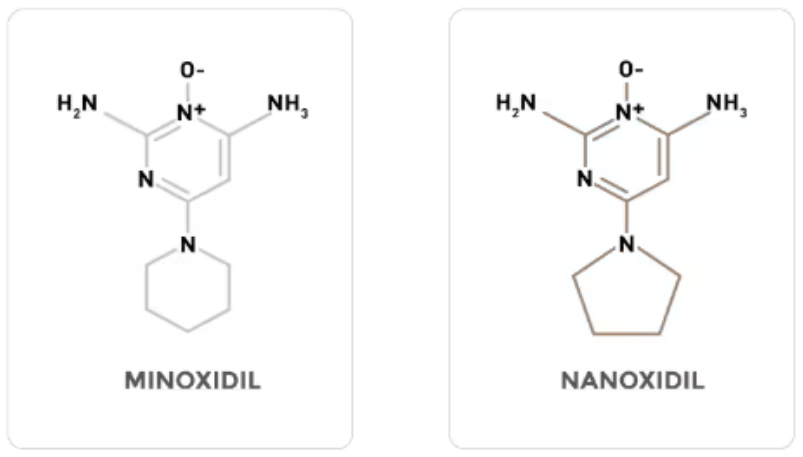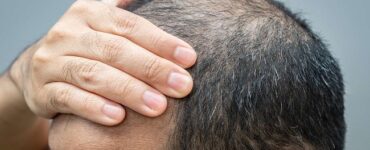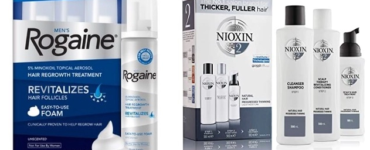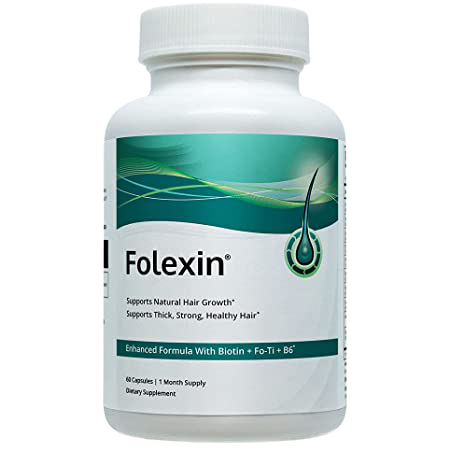If you’re going through hair loss it’s comforting to know that you’re not alone. There are types of hair loss, with the most common one being androgenic alopecia or pattern baldness which affects around 75 million Americans.
If you’re dealing with this potentially distressing condition chances are you’ve come across products claiming to enhance the length, thickness and fullness of your hair. However there is one ingredient that has been approved by the FDA for treating pattern hair loss; topical minoxidil. Minoxidil has been used for years. Now there’s a newcomer called nanoxidil that claims similar benefits.
Table of Contents
Minoxidil vs Nanoxidil – An Overview

What is Minoxidil?
Initially developed as a medication for hypertension in the 1970s minoxidil is now widely used to treat hair loss. It was discovered that one of its side effects was body hair growth leading to its development as a topical treatment for both men and women, with androgenetic alopecia. Topical minoxidil comes in concentrations and forms including both brand name and generic versions. Among them all Rogaine stands out as the choice.
How it Works
The hair follicle growth cycle consists of three phases; anagen, catagen and telogen. According to Ziering minoxidil accelerates the transition, from the resting and shedding phase (telogen) to the growth phase (anagen) reducing the time spent in the rest state and promoting hair growth. In addition Lo Gerfo explains that minoxidil widens blood vessels, enabling delivery of oxygen blood to hair follicles, which supports healthy hair growth.
Using Minoxidil for Hair
Minoxidil is generally safe for use unless you are pregnant or planning to become pregnant. However it is important to consult a dermatologist before using minoxidil. The original and most well known minoxidil product is Rogaine, available in versions for both men and women. There are also options like Hers—a company offering two percent strength minoxidil. Hers provides an choice with a modern look; however it can only be purchased directly from their website. It’s advisable to consult an in person dermatologist to determine the brand and concentration, for your specific needs. The application instructions may vary depending on the product and your dermatologists advice.
To illustrate when using Hers you would apply 1 ml of the product on your scalp whether your hair is damp or dry. Leave it in for a minimum of four hours before repeating the process twice a day.
What is Nanoxidil?
Nanoxidil isn’t just similar, to minoxidil in name. Its molecular composition closely resembles that of minoxidil making it a promising topical solution for hair loss. According to Ziering nanoxidil is a compound that shares an identical molecular structure with minoxidil but with one less carbon chain. This slight variation reduces its weight. Potentially enhances its absorption into the scalp. Notably DS Laboratories exclusively offers nanoxidil as a serum with a concentration of 5 percent.
How does it work?
According to Ziering nanoxidil is believed to function to minoxidil by improving blood circulation and delivering nutrients to the hair follicles, which may promote growth. The serum containing nanoxidil also includes components such, as retinol, which aids in absorption into the skin and anti inflammatory copper peptides. However it’s important to note that there’s currently no clinical trial data or published studies supporting the effectiveness of this treatment according to LoGerfo.
Minoxidil vs Nanoxidil – Which Option is Right for You?
Ziering mentions that there haven’t been any comparisons between nanoxidil and minoxidil in terms of their effectiveness. DS Laboratories claims that nanoxidil has side effects, such as burning, itching and irritation at the application site compared to minoxidil. However this claim hasn’t been independently verified. Harris suggests that while nanoxidil theoretically has the potential to address both hair loss on the crown and hairline minoxidil primarily targets the crown area only. Nevertheless she highlights the lack of data and information on nanoxidils long term effects. The manufacturer of nanoxidil also asserts its effectiveness in treating both alopecia and alopecia areata, which is another type of hair loss caused by a disease.
In summary
When dealing with hair loss concerns it is crucial to consult with professionals. Understanding the cause of your hair loss plays a role in determining an appropriate treatment plan that often involves a comprehensive approach.
However experts have expressed varying levels of skepticism regarding nanoxidil due, to its scientific data availability and lack of FDA approval. On the hand minoxidil has a established track record. It is advisable to consult with a dermatologist or trichologist before making any decisions. Ultimately opting for the tested option provides a path when facing uncertainty.






Add comment